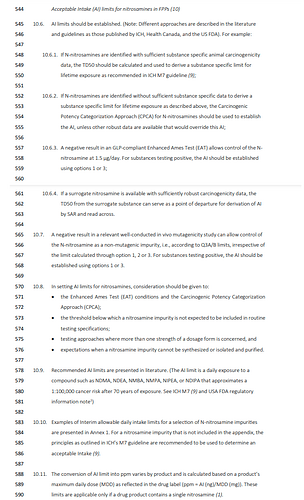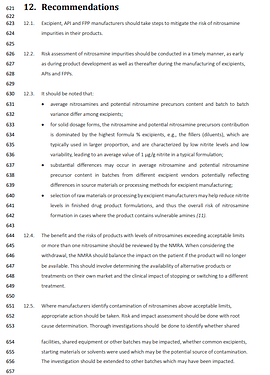WHO is requesting comments for the following draft guidance. Both CPCA and EAT are available for AI settings.
A couple of things I noticed on a first scan through:
This should be secondary, tertiary and quaternary amines, and shouldn’t include amides, which form the nitrosamides and are outside of the scope of nitrosamine regulations (but not ICH M7).
This looks to push a lot of scope back onto excipient suppliers, alongside finished product manufacturers. Very difficult to control from an excipient supplier perspective, as they don’t know the usage levels in finished products, different finished product manufacturers may require different levels. The same reason the USP has said that limits/levels won’t be specified in monographs for materials.
Totally agree Mark.
In the case of excipients, it may be enough if they were at least required to provide testing of nitrites with a LOQ sensitive enough, something on the order of 50-100 ppb?
If drug product manufacturers were to have this kind of information we would be able to make decisions on which supplier/batch to use depending on the requirements of the specific drug product.
Hi, I would like remember that no standardized GMP exists for excipient manufacturers. For EU region, the drug product manufacturers should define the most appropriate GMP level (e.g. ISO or HACCP for excipients which are mainly produced for food use) and evaluate the risks of each supplier:
Guidelines of 19 March 2015 on the formalised risk assessment for ascertaining the appropriate good manufacturing practice for excipients of medicinal products for human use
Currently the GMP certification of the excipients manufacturers may be performed (on voluntary basis) only by EXCiPACT organization:
IPEC Federation Qualification Form for Pharma Companies - EXCiPACT
In other words, the
WHO good manufacturing practices for excipients used in pharmaceutical products is more a recommendation than a legal binding document
Hi everyone,
Am just verifying on the status of the shared WHO GMP considerations for Nitrosamine , has it now been implemented?



